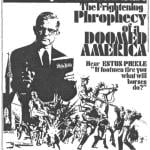This post is part of a series walking through the first volume of Abraham Kuyper’s Common Grace.
The previous two chapters began Kuyper’s discussion of the institution of common grace, particularly as it involves the restraint of total depravity. Specifically we saw how depravity was restrained in the heart of man. In today’s post, we’ll see how depravity is restrained in the body and in nature. This is part of the ‘fixed starting point’ of common grace, in that it both restrains sin and preserves the ‘small sparks’ of God’s Image in man.
This restraint of sin and preservation of God’s image applies to the body as much as to the soul. We are not actually told much about how the Fall affected the body. We are only given three general points:
- Female suffering, especially in childbirth, is now attendant on the blessing/ordinance of man to ‘be fruitful and multiply.’
- Male suffering, especially in physical toil and fruitless labor, is now attendant on the blessing/ordinance of man to ‘subdue the earth.’
- General human weakness now requires the need for clothes (whatever spiritual meaning those clothes may have beyond the physical need for them). (308-310)
From these we can at least infer that this is also the point where sickness and problems of hygiene begin to beset man.
These physical problems are not merely the result of original sin–they are also the result of ongoing sin. Fortunately, in these we also see ongoing common grace. Death reigns, but is delayed. Eve bears children in pain–but she bears them. Adam works fruitlessly in an ultimate sense–but we are fed and the race expands. Sickness spreads–but we at times are healthy. We can even cure or treat some of the sicknesses that beset us. Over and over we see that the result of the fall is held back by God’s merciful hand int the human body.
The same thing is true in the world as well. In the fall of man,
- ‘the earth was cursed because of man’
- the plants changed
- animals changed
- paradise vanished
We’ve already seen how the Flood changed the face of the world and the nature of common grace. Now we are looking back before that and seeing the nature of the original changes brought about in creation by the curse. Kuyper thinks that we can outline four main periods in the physical history of the world:
- when the world was without form;
- the days of creation, culminating in paradise;
- from the curse in paradise to the Flood;
- from the Flood through today to the eschaton. (316)
None of these are scientific descriptions, of course–though the fact that science has confirmed past violent upheaval is of course to be recognized and celebrated.
Aside from whatever scientific causes we may care to suggest, we certainly see the spiritual roots of these natural changes in Scripture. These roots ought to remind us of the organic unity of creation–the spiritual and the physical are not unconnected things.
We also see that man is the focus of creation, even as aspects of our unity with creation remain veiled in mystery. For example, the direct relationship between reward and curse for man’s obedience and disobedience is obscured from our vision–though we know there is such a relationship and that it is organic rather than mechanical.
Common grace, then, is a restraint on the organic results of human sin on the world–it is the charge to the earth to continue to produce bread instead of only producing thorns. There is wilderness left on earth to remind us of what common grace protects us from, as well as beauty to point us to worship.
And again, Kuyper ends by reminding us that common grace in nature “is not particularized” and applies to all of mankind. Unlike particular grace, common grace and the curse alike permeate all of creation. (322-323)
Dr. Coyle Neal is co-host of the City of Man Podcast and an Associate Professor of Political Science at Southwest Baptist University in Bolivar, MO













